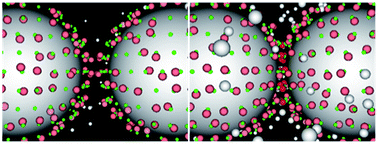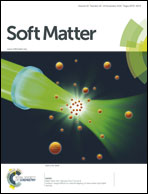Colloidal potentials mediated by specific biomolecular interactions†
Abstract
We present a systematic study of receptor–ligand interactions with increasing complexity from interactions in bulk solution, on planar and colloid surfaces, and as part of mediating colloidal pair interactions. We report analytical models that relate receptor–ligand dissociation constants (KD), interactions potentials (U(r)), and adsorbed amounts (θ) for different ligand sizes, concentrations and immobilized receptor coverages. Analytical results are validated for hard core + harmonic well receptor–ligand interactions in bulk and interfacial systems using Monte Carlo (MC) simulations, although any biomolecular interaction can be incorporated into the reported analysis via a “B2 device”. Results from analytical models are used to understand potentials of mean force (W(L)) for ligand mediated interactions between receptor decorated colloids. W(L) are generated using MC-umbrella sampling (MC-US) simulations with cluster moves, which provide self-consistent comparisons of net colloid scale interactions with receptor–ligand scale information. Our findings capture how receptor–ligand interactions mediate colloid scale interactions relevant to self-assembly, drug delivery, and biosensing.


 Please wait while we load your content...
Please wait while we load your content...